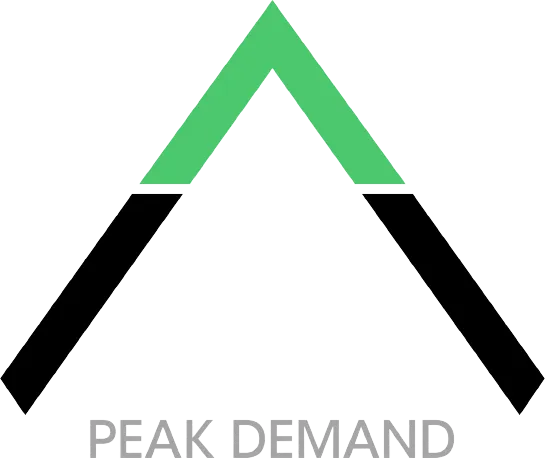AI Agency Automation Services & SEO
Toronto, Ontario, Canada
Let's climb to the top of your market, one custom automation at a time.
Phone: +1 (647) 691-0082
Email: [email protected]
Automated Voice AI Call Centre Using AI Agents with Personality
Agents that Work 24/7 - No Hold Times
Dedicated Phone Numbers
Speak to Multiple Customers
Speak in Multiple Languages
Customized Personality and Accents
Trained On Any Service or Document
Book Appointments Onto Calendars
Update CRM After Data Extraction
Provide Post Call Reports
Never Take Breaks
Never Get Tired
Never Retire
Customer Service Operations, Technical Support, Sales, After Hours
AI News, AI Updates, AI Guides

Top 10 Mistakes Healthcare and Service Businesses Make After a Receptionist Quits and How to Avoid Them
Receptionist Quits: Unexpected Crisis for Healthcare and Service Businesses

When a receptionist quits unexpectedly, it creates a high-risk service gap—especially in healthcare and other inbound phone–dependent businesses. Clinics, dental offices, veterinary practices, urgent care centers, and similar service providers rely on every call. Lost calls become lost appointments, eroded trust, and leaking revenue.
This article walks through the top 10 mistakes organizations make after a receptionist quits and exactly how to avoid each one. You’ll get a rapid-response mental model so the next quit doesn’t turn into a crisis.
What you’ll learn:
Why silence or delay costs more than you think
How to keep calls answered instantly (human + AI fallback)
How to capture and recover leads before they disappear
How to communicate clearly to patients/clients during the gap
Ways to build redundancy so future quits are non-events
Read on to turn a sudden departure into operational resilience and keep your front desk functioning—no matter who’s gone.
1. No Documented Emergency Coverage Plan after Receptionist Quits

The mistake: Relying on improvisation or memory when your receptionist quits instead of having a predefined, written backup process.
Why it hurts:
Wasted time deciding who covers phones, what to say, and how to route calls.
Inconsistent responses that confuse patients/clients.
Missed opportunities—appointments, leads, urgent inquiries—while the team scrambles.
Stress cascades across staff, degrading trust internally and externally.
What to do instead:
Build and maintain a formal Emergency Coverage Playbook that can be activated the moment a receptionist quits. Key components:
Activation Trigger & Owner
• Define who is responsible for “flipping the switch” when the receptionist quits (clinic manager, operations lead, etc.).
• Include a clear trigger (e.g., resignation received, no-show on first day of coverage gap).Immediate Coverage Pathways
• Pre-authorize an AI voice receptionist or after-hours answering service to turn on instantly.
• List human fallback options (cross-trained staff, on-call temps) with contact/step-by-step activation instructions.Scripted Call Flows & Templates
• Emergency front-desk script for incoming callers (“Our front desk is temporarily adjusting; we’re covering your call with backup support—how can I help?”).
• Triage questions, escalation rules, and key phrases to capture intent and urgency.Lead Capture & Handoff Protocol
• Ensure incoming call details are logged automatically (via AI system or structured manual notes) and synced to your CRM/EHR.
• Define how follow-ups are assigned and tracked during the gap.Communication Plan
• Prewritten messaging for patients/clients: phone hold messages, website banner copy, and outbound appointment reminder updates explaining the temporary shift in coverage.Role & Responsibility Matrix
• Who monitors the temporary system? Who escalates failures? Who transitions to the permanent replacement?Rehearsal & Update Cadence
• Regularly test the playbook with tabletop exercises (e.g., simulate a quit).
• Review and revise quarterly or after any real activation.
Quick Emergency Playbook Checklist:
Coverage owner & activation trigger identified
AI receptionist / answering service pre-configured and ready
Backup human contacts (cross-trained/internal) listed
Call scripts and escalation rules documented
Lead capture + logging mechanism in place
Patient/client communication templates prepared
Responsibilities assigned for monitoring and handoff
Scheduled test of the playbook
By codifying this plan ahead of time, a receptionist quitting becomes a momentary bump—not a breakdown.
2. Wasting Time Searching for a Solution or Delaying Activation on AI Voice systems after Receptionist Quits

The mistake: Spending hours or days debating, hunting for temporary coverage, or waiting on approvals instead of turning on an immediate fallback when your receptionist quits.
Why it hurts:
Every hour of delay means unanswered calls, lost appointments, and slipping leads.
Patients/clients assume the practice is unavailable or disorganized.
Momentum and trust erode while staff scramble, creating unnecessary stress and reactive firefighting.
Opportunity cost compounds: the longer the gap, the harder recovery becomes.
What to do instead:
Pre-authorize instant backups: Have an AI voice receptionist or after-hours answering service pre-configured and ready to activate with a single decision.
Keep credentials & scripts accessible: Store login info, call flows, and fallback messaging in a known “emergency inbox” or operations toolkit so activation doesn’t require hunting through emails.
Define a decision tree: Include a clear “if receptionist quits, then…” checklist in your playbook—who flips the switch, which system comes online first, who communicates outward.
Maintain an on-call short-term human roster: Have pre-vetted temp/replacement contacts (cross-trained staff or contractors) with a rapid briefing kit so they can step in same-day if needed.
Automate the trigger: Tie resignations or coverage failures to automatic workflows (e.g., a notification from HR or scheduling system that triggers the AI fallback to go live immediately).
Use templated emergency scripts: Ready-to-use messaging for staff and patients so responses are immediate—no writing from scratch under pressure.
Quick action checklist:
AI/overflow system pre-configured and activation procedure known
Emergency credentials & call scripts bookmarked and accessible
Decision owner identified and empowered to flip the switch
Temp/backup human list with briefing kit ready
Automatic or manual trigger path documented for immediate activation
Turning a receptionist quits moment into a near-instant switch-over dramatically reduces lost volume and keeps your front desk visible, responsive, and trusted.
3. Letting Inbound Calls Go Unanswered after Receptionist Quits

The mistake: Leaving the phone silent or sending callers to dead voicemail during the gap after a receptionist quits.
Why it hurts:
Missed appointments and lost revenue from leads who never get a response.
Frustrated patients/clients assume the practice is closed or unreliable.
Brand damage accumulates as word-of-mouth spreads about poor availability.
Recovery becomes harder the longer the silence persists—cold leads decay fast.
What to do instead:
Immediate call rerouting: Automatically divert incoming calls to a preconfigured backup system (AI voice receptionist, overflow answering service, or cross-trained staff).
Fallback scripts & IVR prompts: If the primary line is unmanned, play a brief message explaining temporary coverage and offer options: “Press 1 to book, 2 to leave a callback request, 3 to speak to on-call support.”
Layered redundancy: Combine AI pickup with human escalation—AI answers basics instantly and flags/forwards complex or urgent calls to live staff.
Real-time monitoring: Have someone (or a dashboard) watching call volume and abandonment rates so gaps are noticed and corrected immediately.
Callback automation: If a caller leaves a message, trigger an automated confirmation (SMS/email) that their request was received and indicate expected follow-up time.
Visible availability indicators: Update website, phone hold messaging, and appointment portals to reflect that backup coverage is active—reducing caller anxiety.
Quick action checklist:
Calls auto-reroute to backup AI or overflow system
Emergency IVR/hold message in place explaining temporary coverage
Escalation path defined for complex calls
Callback acknowledgments automated
Monitoring dashboard or person tracking missed/abandoned calls
Ensuring no inbound call goes unanswered turns a potential blackout into a seamless bridge, preserving appointments, trust, and revenue.
4. Losing Leads from Failure to Capture and Follow Up after Receptionist Quits

The mistake: Letting caller intent disappear—no structured capture, no persistence, and no automated follow-up when your receptionist quits.
Why it hurts:
Potential patients and clients fall out of the funnel and never return.
Revenue leaks as missed or half-handled inquiries decay into silence.
Staff waste time chasing fragmented or forgotten context.
The practice appears unresponsive, weakening trust and referral momentum.
What to do instead:
Real-time lead capture: Every inbound call (answered by backup human, AI receptionist, or overflow service) must log caller name, contact info, reason for calling, and urgency. Use systems that auto-populate this into your CRM/EHR or a temporary structured intake form.
Automated immediate follow-up: Trigger an acknowledgment via SMS, email, or voice: “We received your request about [topic]; someone will follow up within X hours.” Include next-step instructions or a quick scheduling link.
Fallback manual logging: If the primary system isn’t live yet, have a simple digital form or shared spreadsheet template frontline staff or interim cover can fill out instantly. Later sync or batch-import into the master system.
AI-assisted transcription & intent tagging: Use the AI receptionist to transcribe calls, extract key intents (e.g., appointment request, prescription refill, urgent symptom), and surface red flags for prioritized follow-up.
Lead scoring & prioritization: Assign scores based on urgency, patient value (new vs. returning), and contact behavior so high-impact leads get fast human attention.
Persistent recovery workflows: Unanswered or unconverted leads automatically roll into nurturing sequences: reminder nudges, second outreach, and escalation if unresponsive after predefined intervals.
Scripted follow-up touchpoints: Provide templates for interim staff or AI to use:
• “Hi [Name], we missed your call about [issue]. Can we reschedule your appointment for [proposed times]?”
• “Just checking in—did you still want to book your follow-up visit? Reply YES to confirm.”
Quick action checklist:
Lead capture system active (AI/overflow/manual fallback)
CRM/EHR integration or temporary structured intake ready
Automated acknowledgment messages configured
Call transcription and intent tagging enabled if using AI
Lead scoring rules defined for prioritization
Recovery sequences in place for unconverted leads
Follow-up scripts/templates available to cover staff
Capturing and following up on leads immediately turns a receptionist quits event from a potential loss into an opportunity for recovery and increased loyalty.
5. Single Point of Failure / No Redundancy after Receptionist Quits

The mistake: Relying on one person (the receptionist) to hold all operational knowledge, call scripts, escalation rules, and fallback procedures.
Why it hurts:
When that person quits, institutional knowledge disappears overnight.
Recovery slows dramatically because no one else knows the nuances, scripts, or priority calls.
Mistakes multiply: inconsistent caller handling, missed escalations, lost context.
The practice becomes brittle—future quits or absences cause the same disruption repeatedly.
What to do instead:
Cross-train backups: Ensure at least one other staff member (or two) is familiar with front-desk call flows, triage logic, scheduling quirks, and escalation paths.
Shared, living documentation: Maintain a centralized, concise “front desk handbook” with scripts, common scenarios, key contacts, and emergency procedures. Keep it accessible (cloud/shared drive, operations dashboard).
Layer in AI redundancy: Deploy an AI receptionist or voice-AI fallback as a shadow system that mirrors real workflows—ready to pick up automatically when human coverage gaps occur.
Hybrid handoff architecture: Combine human and AI coverage so no single actor is the only path—AI handles routine and after-hours volume while humans take over complex or empathy-heavy calls.
Regular redundancy drills: Simulate a receptionist quitting or being unavailable to ensure backups and AI systems activate seamlessly and staff know their temporary roles.
Quick action checklist:
At least one cross-trained human backup assigned
Updated shared documentation (scripts, escalation, scheduling) accessible
AI receptionist / voice-AI shadow system running or preconfigured
Defined hybrid coverage model (who handles what when primary is gone)
Scheduled drills/testing of redundancy plan
Eliminating single points of failure turns a receptionist quitting from a catastrophic outage into a manageable staff transition.
6. Poor Communication to Patients/Clients About the Change after Receptionist Quits

The mistake: Staying silent or sending vague signals after the receptionist quits instead of proactively informing patients/clients about the temporary disruption and coverage plan.
Why it hurts:
Clients assume the practice is understaffed, unorganized, or closed.
Trust erodes quickly when people feel left in the dark.
Confusion leads to repeat inquiries, double-booking, and unnecessary escalations.
The gap amplifies perception of service breakdown, making recovery harder even after coverage is restored.
What to do instead:
Deploy clear, consistent messaging immediately across all touchpoints so patients/clients know what’s happening and that coverage is active.
• Phone system announcement/hold message: “Our front desk team is temporarily adjusting. We’ve activated backup coverage—please hold or press 1 to schedule, 2 to leave a callback request.”
• Website banner or pop-up: “Receptionist has recently left; we’re covering your calls with our backup system. Appointment booking and inquiries are still being handled in real time.”
• Email/SMS broadcast to recent or upcoming patients: “Heads up: Our front desk is using temporary support this week. If you called and didn’t reach us, we’ve got you covered—reply or click here to confirm your visit.”
• Social or portal notice: “Temporary front-desk update—calls are being answered via our emergency coverage system. Thanks for your patience.”Set expectations clearly: Include estimated timelines (“We expect normal front-desk staffing to resume by [date]”) and provide alternative contact paths (AI receptionist, direct scheduling link, escalation for urgent issues).
Use empathetic language: Acknowledge inconvenience (“We know changes can be frustrating”) and reassure continuity (“Your care isn’t interrupted; here’s how we’re handling it”).
Train interim staff or AI scripts to echo the same messaging so every caller hears the same explanation and knows what to expect next.
Offer a quick FAQ snippet on common questions: “Is the clinic open?” “How do I book?” “Who do I talk to for urgent matters?”
Quick action checklist:
Update phone hold/announcement script with temporary coverage message
Publish website banner or front-page alert
Send templated email/SMS to affected patients/clients
Post notice on patient portal and relevant social channels
Ensure interim human or AI scripts use consistent, empathetic language
Provide an FAQ section or auto-reply addressing top concerns
Include expected timeline and alternative contact options
Proactive, transparent communication turns a potential trust gap into a moment of reliability—patients notice when you manage disruption with clarity instead of silence.
7. Slow or Inadequate Deployment of Temporary or AI Backup after Receptionist Quits

The mistake: Hesitating, fumbling, or misconfiguring fallback coverage after a receptionist quits—taking too long to get temporary human support or AI systems fully live.
Why it hurts:
Gaps widen while calls go unanswered and leads cool off.
Setup friction (wrong scripts, missing credentials, broken integrations) delays recovery even when a backup is theoretically available.
Staff waste time manually patching solutions instead of executing a ready plan.
First impressions worsen if the interim system feels half-baked or inconsistent.
What to do instead:
Pre-provision backup systems: Have your AI receptionist(s) and overflow answering services already configured with default scripts, authentication, and integration hooks so they can be toggled on instantly.
Maintain a hot standby human roster: Keep a vetted list of cross-trained internal backups or pre-contracted temps with a one-click briefing kit ready to deploy.
Automate activation triggers: Tie receptionist departure signals (HR notification, schedule gap detection, missed shift alert) to workflows that automatically enable AI voice coverage and notify the fallback team.
Use configuration templates: Store versioned call-flow templates, escalation rules, and messaging presets so temporary or AI coverage always uses consistent, approved language.
Health checks & real-time validation: Immediately after backup spins up, verify it’s working—test inbound calls, confirm lead capture/logging, and surface any integration errors to a responsible owner.
Fallback rollback & augmentation: If the first-tier backup underperforms, have secondary options (alternate AI persona, second temp, manual triage escalation) ready without delay.
Routine readiness drills: Regularly simulate a receptionist quitting to practice activation, reduce friction, and surface hidden failure points before real incidents.
Quick action checklist:
AI receptionist/answering service pre-configured with scripts and credentials
Backup human list with one-click onboarding kit available
Automated trigger workflow defined and active for immediate switchover
Configuration templates for call flows and escalation available
Post-activation health check procedure in place
Secondary fallback options prepped (e.g., alternate AI flow or additional temp)
Scheduled simulations to test readiness
Fast, reliable deployment of temporary or AI backup turns a sudden receptionist quit from a service gap into an almost invisible handoff—preserving calls, leads, and trust.
8. Failure to Transfer Knowledge or Train Interim Staff after Receptionist Quits

The mistake: Throwing interim or temporary cover into the front line with no context, scripts, or quick onboarding after the receptionist quits.
Why it hurts:
Longer call handling times and inconsistent answers.
Escalation confusion when interim staff don’t know priorities or thresholds.
Loss of caller trust due to mixed messaging or repeated questions.
Increased errors and dropped follow-ups because context wasn’t handed off.
What to do instead:
Maintain a “Front Desk Briefing Kit” that’s always up to date and instantly shareable. Include:
• Standard call scripts (appointment booking, cancellations, urgent triage)
• Escalation rules and red-flag keywords
• Key contact list (clinicians on call, billing, technical support)
• Common FAQs and how to answer them
• Login credentials or access paths (securely stored)Create a 5–10 minute quick-start onboarding summary (document or short video) that any interim staff or temp can consume before taking a call.
Use templated annotation: If the departing receptionist can, have them annotate recent unusual cases, hot leads, or in-flight appointments in a shared dashboard or handoff note.
Shadow and pair briefly: If possible, have the interim person listen in or co-handle the first few calls (even virtually) to absorb tone and flow.
Leverage AI to surface context: If using an AI receptionist or voice agent, ensure its summaries/transcripts are available to interim humans so they inherit the prior conversation context immediately.
Quick action checklist:
Up-to-date front desk briefing kit accessible
Quick-start onboarding summary ready for temps/interim staff
Standard call scripts and escalation rules documented
Key contacts and urgent paths clearly listed
Recent critical cases annotated or summarized for handoff
Interim staff given access to AI-generated call summaries/transcripts (if applicable)
Brief shadowing or pairing session arranged where feasible
Proper knowledge transfer and rapid training make interim coverage smooth, reducing friction and preserving the integrity of patient/client interactions.
9. Ignoring After-Hours and Peak Demand Call Handling after Receptionist Quits

The mistake: Treating the receptionist gap as a daytime-only problem and failing to extend coverage into nights, weekends, or surge periods.
Why it hurts:
Critical inquiries outside normal hours go unanswered, leading to lost appointments and emergency escalation delays.
Opportunity windows (late-night scheduling, urgent customer needs) vanish because no one is available to pick up.
Patient/client frustration grows when they can’t reach anyone during peak or off hours, damaging loyalty and referrals.
The “quiet” periods mask underlying demand spikes—failure to plan means the next surge overwhelms the understaffed fallback.
What to do instead:
Deploy after-hours answering service or AI voice receptionist that automatically handles inbound calls 24/7, capturing intent and triaging urgency.
Configure surge-aware fallback logic: Predefine rules that increase responsiveness during known peak times (seasonal flu, billing cycles, promotional campaigns) so coverage scales without manual intervention.
Use layered coverage: Combine AI for immediate pickup with human follow-up during transitions (early morning handoff, next-day callbacks) to keep continuity.
Extend scripts for off-hour scenarios: Ensure call flows include clear options for urgent issues, scheduling next available slots, and leaving secure messages that trigger rapid recovery workflows.
Real-time alerting: Notify on-call staff or managers when after-hours volume or abandonment rates spike so temporary adjustments (e.g., adding live backup) can be made quickly.
Predictive staffing triggers: Use historical call data to anticipate peak demand windows and pre-activate additional AI personas or on-call humans before the surge hits.
Quick action checklist:
After-hours AI receptionist or answering service active and tested
Surge rules defined and tied to automated escalation/resourcing
Hybrid handoff plan between AI (immediate) and humans (next-step) in place
Off-hour call scripts include triage options and clear next steps
Monitoring alerts set for volume spikes and abandonment
Historical data reviewed to forecast upcoming peak periods
Handling after-hours and peak demand proactively ensures that a receptionist quitting doesn’t turn into a blackout—patients and clients always have a reliable, responsive voice on the line.
10. Neglecting Data Logging and Skipping Exit Learning after Receptionist Quits

The mistake: Failing to record what happened during the gap and not extracting lessons from the receptionist quitting—no audit trail, no structured feedback, and no updates to prevent recurrence.
Why it hurts:
Repeated vulnerabilities: the same gaps happen again because root causes aren’t addressed.
Loss of context: interim staff, AI systems, or replacements operate blind without understanding what failed, making handoffs clunky.
Missed improvement opportunities: quitting triggers reveal systemic pain points that go unexamined.
Accountability gaps: without logs or post-mortem insights, it's impossible to measure impact or justify investments in resilience.
What to do instead:
Enforce automatic data logging: Every inbound interaction during the gap—calls, messages, escalations—should be timestamped, transcribed (if voice), tagged with intent, and appended to the patient/client record or CRM.
Capture failure metrics: Track unanswered calls, lead loss, recovery rates, average response time, and any misrouted or dropped handoffs during the disruption window.
Conduct a structured exit review: Whether the receptionist quit abruptly or gave notice, do a rapid “exit learning” session: ask what broke, what was painful, what was missing in training or tooling, and why they left (if possible).
Run a post-event debrief: Convene operations, front-desk backups, and tech owners to compare what was supposed to happen vs. what actually occurred. Identify friction points in activation, escalation, communication, and lead recovery.
Update the playbook and onboarding: Feed findings into the emergency coverage playbook, training kits, and redundancy documentation. Adjust scripts, triggers, and backup roles based on real-world failure modes.
Close the loop with metrics: After changes, monitor whether similar future events recover faster or lose fewer leads—use the data to validate improvements and refine again.
Quick action checklist:
All gap-period interactions logged and archived (calls, messages, escalations)
Key failure metrics collected and reviewed (missed calls, lead loss, response lag)
Exit learning session conducted with departing receptionist if possible
Post-mortem debrief held with stakeholders
Playbook, scripts, and training materials updated based on findings
Follow-up tracking in place to validate that changes improved resilience
Capturing what went wrong—and why—turns a chaotic “receptionist quits” event into a catalyst for a more durable, smarter front-desk operation.
Conclusion & Next Steps: Turning a Receptionist Quits Moment into Operational Resilience
A receptionist quitting doesn’t have to become a disaster—if you act fast, learn deliberately, and bake redundancy into your operation. The real difference between a temporary hiccup and a cascading failure is preparation and execution.
What to do now (prioritized rapid-response checklist):
Activate backup coverage immediately: Flip on your preconfigured AI receptionist or overflow answering service.
Reroute and capture every call: Ensure all inbound intent is logged, acknowledged, and fed into follow-up workflows.
Communicate clearly: Notify patients/clients about temporary front-desk adjustments with transparent, empathetic messaging.
Bring interim staff up to speed: Deliver the front desk briefing kit and contextual summaries so they can handle calls with confidence.
Monitor gaps in real time: Watch call volumes, abandonment, and lead recovery metrics; adjust escalation as needed.
Conduct exit learning & debrief: Capture what broke, why the receptionist quit (if possible), and where the playbook failed.
Update documentation: Feed lessons into your emergency coverage playbook, training kits, and redundancy plan.
Institutionalize hybrid resilience: Combine human and AI layers so the next quit triggers a seamless handoff instead of a breakdown.
Longer-term resilience moves:
Schedule regular drills to simulate coverage gaps.
Maintain cross-trained backups and always-on AI shadow systems.
Use data from disruptions to refine lead recovery, escalation criteria, and communication scripts.
Turning a “receptionist quits” event into operational resilience means shifting from reactive firefighting to proactive redundancy. For clinics and service businesses serious about continuity, the next step is to codify this hybrid human+AI model and test it in a controlled pilot—so the next departure barely causes a ripple.
Learn more about the technology we employ.

Try Our AI Receptionist for Healthcare Providers. A cost effective alternative to an After Hours Answering Service For Healthcare
AI Agency Digital Marketing Services
AI Guided Website Design
Our AI-driven studio builds lean, conversion-first websites—no flash, just function. We strip away the clutter and use data-backed layouts, clear CTAs, and continuous optimization to turn visitors into customers. You stay focused on growth; we make your site your top lead generator.
AI Driven SEO Services
Our AI-powered SEO services zero in on high-intent keywords and technical precision to secure top rankings, attract targeted organic traffic, and convert visitors into qualified leads—so your website works smarter, not louder.
AI Personalized Email Marketing
Our AI-driven platform crafts hyper-personalized messaging using your custom business data points and each customer’s unique journey—so every touch feels relevant, timely, and drives real engagement.
AI Automation
Our AI-driven automation suite—including intelligent voice agents—makes real-time decisions to streamline your entire workflow. Voice agents handle inbound calls, route requests, and trigger follow-up actions, while our backend automation manages task handoffs, exception escalations, and data sync. You save valuable time and boost efficiency, letting you focus on what matters most as our intelligent solutions propel your business forward.
AI Powered Chatbots
Our AI-driven chatbots are available 24/7 across every channel—website widget, SMS, email, voice agents, and social media. They instantly answer questions, capture leads, and boost customer satisfaction with seamless, efficient interactions that never sleep.
AI Powered Voice Agents & Call Centre Services
Our SOC 2-, HIPAA-, and PIPEDA-compliant AI voice agents elevate your call center operations—delivering 24/7 customer service (including after-hours) across every channel, from website widget to SMS, email, social media, and phone.
These intelligent agents can:
Handle Queries & Generate Leads: Instantly resolve questions, qualify prospects, even upsell services.
Automate Workflows: Route calls, trigger follow-up SMS or emails, and hand off complex issues to live staff.
Capture & Sync Data: Extract custom fields from conversations—patient info, service requests, consent confirmations—and funnel detailed call reports directly into your CRM.
Ensure Continuous, Secure Support: With end-to-end encryption, role-based access, and full audit logs, you maintain compliance and build trust.
Streamline operations, boost efficiency, and keep customers—and regulators—happy with focused, always-on AI voice automation.
SEO Agency Organic Lead Generation Services
AI-Driven SEO Services for Canada and U.S.
Our AI-powered SEO agency combines strategic insight with machine learning to help service-based businesses across Canada and the U.S. rank higher, get found in search and AI tools like ChatGPT, and generate organic leads at scale. Whether you're a medical clinic in Ontario or a construction firm in Texas, we tailor every SEO campaign to your location, audience, and goals.
Local SEO Services for Businesses in North America
We optimize your Google Business Profile, enhance map pack visibility, and build location-specific content that drives inbound calls, bookings, and walk-ins. Perfect for HVAC companies, dental clinics, med spas, auto repair shops, wellness centers, and multi-location brands looking to dominate their region.
Technical SEO Optimization AI-Ready Site Structure
We conduct in-depth technical audits to resolve crawl errors, broken schema, slow load speeds, and mobile UX issues. Then we optimize your architecture so your website performs better in search engines—and gets indexed and recommended by AI tools like ChatGPT and Gemini.
SEO Content Strategy & Publishing
We build conversion-first landing pages, blogs, and service content using AI-enhanced keyword research and real-time search intent. Whether you serve one city or multiple states/provinces, we write content that speaks directly to your customers and helps you rank for exactly what they’re searching for.
Competitive Analysis Intent Keyword Targeting
We uncover the high-converting keywords your competitors are ranking for (and the ones they’re missing). Then we launch SEO assets engineered to outrank them in both organic search results and AI-assisted responses.
Backlink Building Services for Canada and U.S.
Peak Demand’s backlink services strengthen your domain authority and drive organic traffic with high-quality, earned links from trusted sources. We build SEO-optimized backlink strategies tailored for Canadian and U.S. service businesses, combining local citations, industry blogs, and digital PR outreach. Our team audits, analyzes, and secures powerful backlinks that improve search rankings, support AI search visibility, and attract qualified leads—without spam or shortcuts. Perfect for businesses targeting growth in competitive markets.
SEO for RFP Visibility in North America
Want to show up when procurement teams look for vendors? We use schema markup, NAICS code targeting, and certification-rich landing pages to boost your visibility for government contracts and public RFP searches across Canada and the U.S.
AI Agency End Game Goal for Our Clients
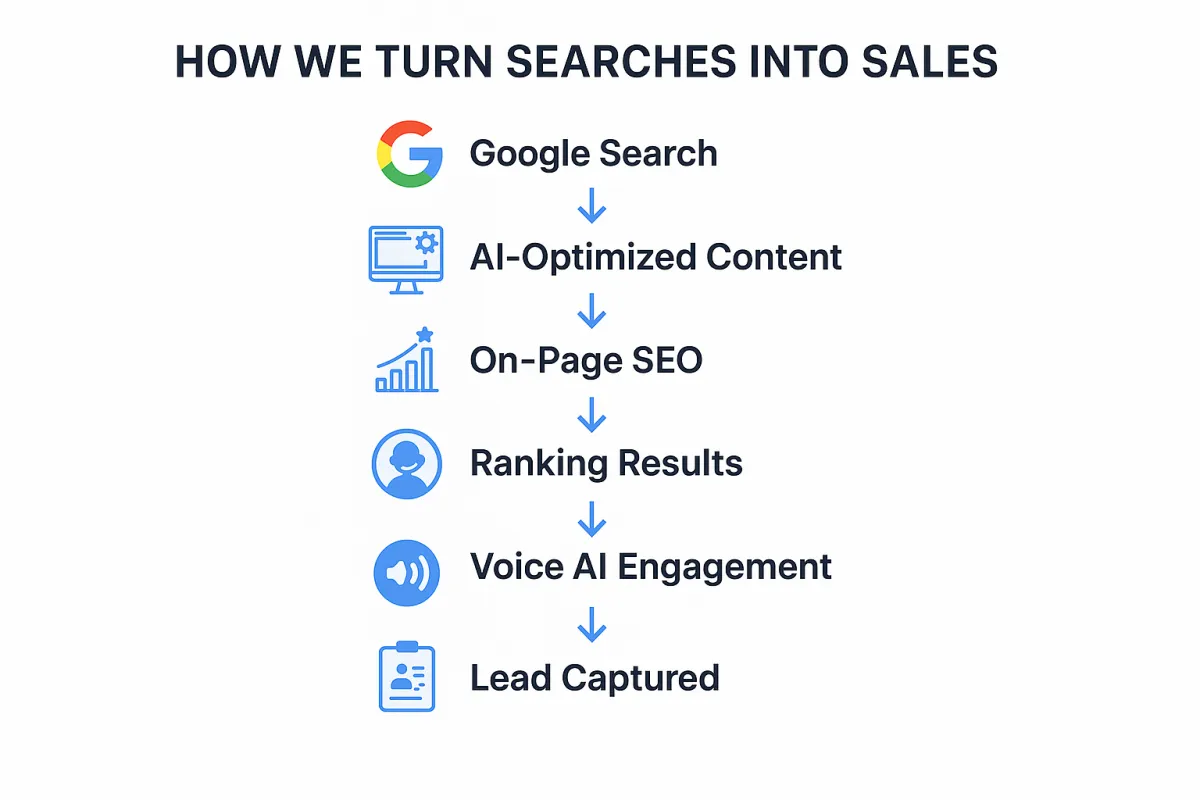
Complete Front End Automation Solutions
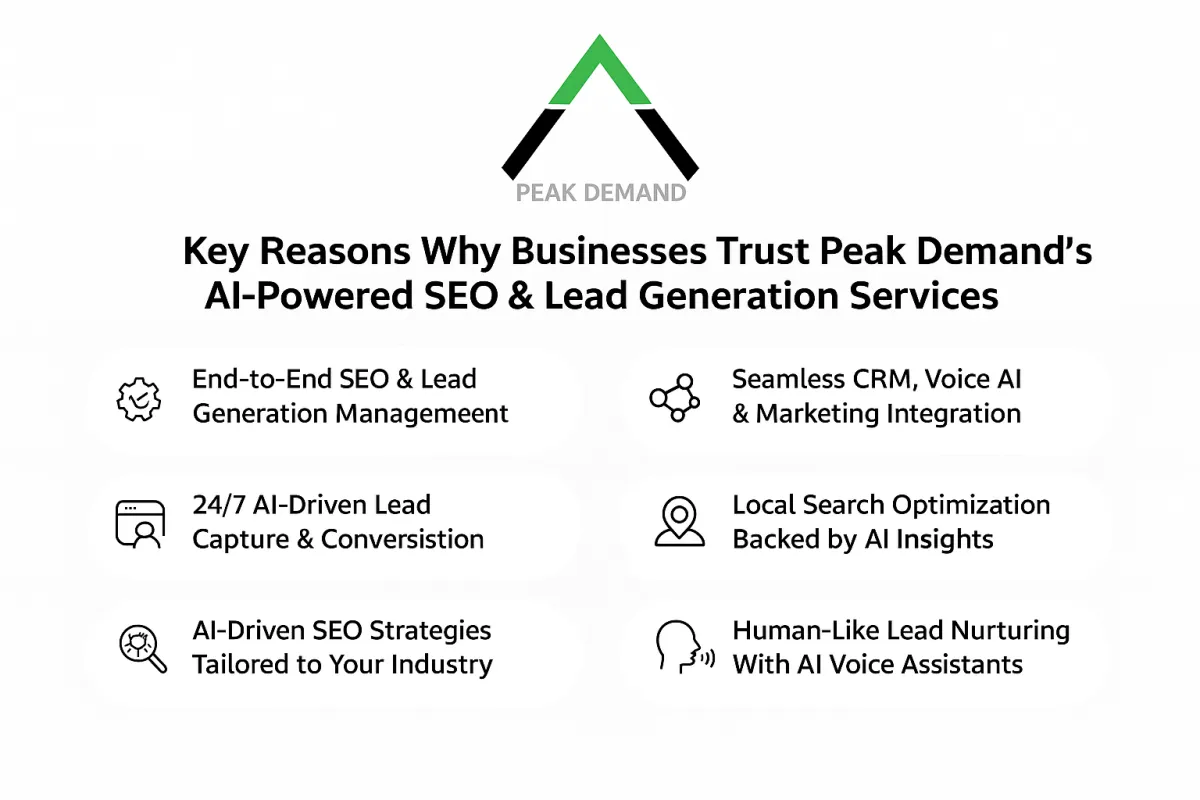
Develop AI Agents that
Automate Workflows and Complete Tasks
Partner with an AI Agency in Toronto for:
Appointment Booking
Prospecting & Lead Generation
Lead Qualification
Technical Support
Customer Service
Customer Follow Up
Knowledge Bases
Human Resources
On-boarding & Training

Call our assistant Sasha and let her know what your team needs - +1 (647) 691-0082
See more agent prototypes on Peak Demand YouTube channel.
We leverage AI to power your business by:
Building powerful websites with 'intention' that convert visitors into customers.
Your website is your base camp - a critical foothold on your journey towards peak demand. We craft not just aesthetically pleasing, but high-converting websites that transform visitors into customers. From innovative design to intuitive navigation, we take care of every detail to ensure your digital platform is primed for success.
Boosting your brand's online visibility to generate high-quality leads.
In the vast digital landscape, standing out can feel like scaling Mount Everest. We're here to build a safe and reliable path for you. Leveraging a mix of SEO strategies, engaging content, and data-driven marketing, we enhance your online visibility and attract high-quality leads to your business. You can focus on your day to day, while we manage your climb to the top of search rankings.
Streamlining your digital communication with cutting-edge automation.
Effective communication is your reliable guide assisting you with client relations. We incorporate advanced technology to automate essential interactions, from follow-up emails to appointment reminders. Our comprehensive management lets you focus on providing top-tier services, knowing your communications are timely and professional.
Establishing a respected reputation within your target region and industry.
Reaching the peak of demand in your region is more than just climbing altitudes; it's about the mark you leave behind - your legacy. We aid in crafting a resilient reputation for your business, one that resonates within your service area and industry. From managing online reviews to producing impactful content, we'll ensure your flag flies high, marking your position stick as a trusted and respected leader.
Growing, manage, and cultivate your digital presence with a powerful platform.
The terrain of the digital world can be as challenging and treacherous as a rugged mountain range. We're here to guide you on your journey. By employing the right tools and strategies to manage your digital presence, we plan for your growth. Our full-service approach covers all aspects of your digital marketing. From client interactions to marketing analytics, we will navigate a clear path towards peak demand in your target market.
All-In One CRM Platform Features & AI Tools
Peak Demand gives you everything you need to power up the digital side of your business. Here's a few favourites.
Sales Funnels

Convert Website Traffic into Sales and Customers
Websites

Build Infinite Websites and Landing Pages
CRM
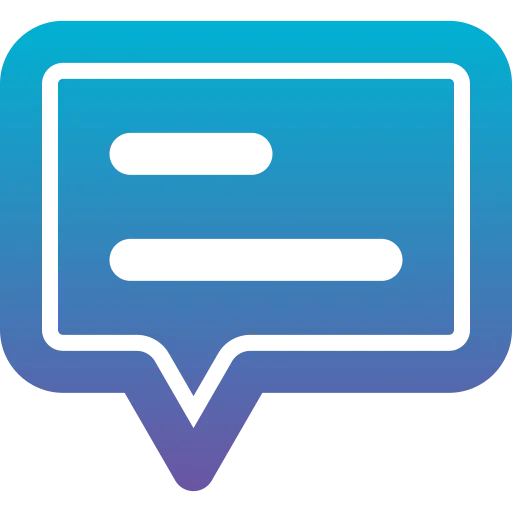
Store Customer Data and Build Pipelines
Email/SMS

Send Emails and Texts to Your Database
Calendars
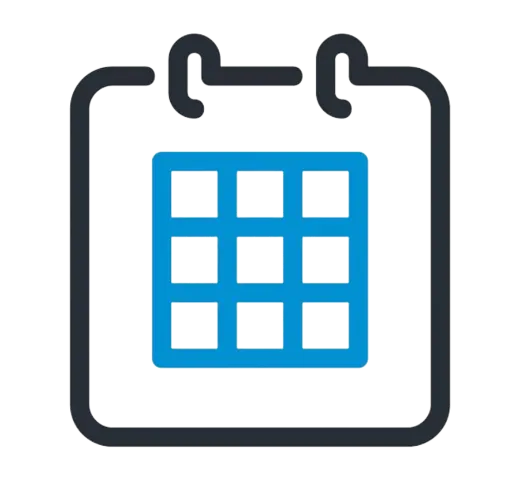
Book Appointments on Connected Calendars
Collect Payments

Invoices, Contracts,and Online Payments are Easy
AI Automations

Build Comprehensive Workflows powered by AI
Integrations

Connect with Thousands of Apps via API
Digital Marketing CRM Platform FAQs
How much does Peak Demand's marketing platform cost, and can I cancel any time?
Peak Demand's comprehensive digital marketing platform costs $197/month for access to all features, done-for-you templates and unlimited support. Yes you can cancel any time. You can also upgrade to higher service packages for monthly services from our team.
Do I need web hosting account?
No you don’t, hosting is included.
Do I have complete ownership of any content I publish on Peak Demand?
You have 100% legal ownership of any content you create on Peak Demand or upload to the platform.
Can Peak Demand build my website for me?
Yes, our team can build your website for you. Once you are subscribed to a plan, there are additional custom services available, including website build-outs.
How many funnels, websites, courses/memberships and domains can you have?
You can have unlimited funnels, websites, courses/memberships and domains in your plan. One subscription allows you to build any number of websites.
Can I use my own domain?
Yes you can use a domain you already own. You have the ability to add unlimited domains, so you can create multiple websites. Peak Demand can also manage your domain for you as part of our custom services.
Can I deploy an AI-powered chatbot that knows specifically about my business and services?
Yes you can deploy a customer service chatbot that is powered by artificial intelligence on your website. This AI chatbot will answer prospect questions via SMS and email and can also help convert them into leads by booking them into your calendar.
How much does an AI-powered chatbot cost?
The cost of deploying a chatbot depends on the complexity and training of the AI. What do you intend the chatbot to do? How much do you want the chatbot to know? We will work with you directly to fully understand your expectations of the chatbot, and determine the best strategy for deployment and associated costs to develop.
What social media platforms does Peak Demand integrate with?
Peak Demand is integrated with Facebook, Twitter, Instagram and LinkedIn.
Can I move websites or courses from other platforms?
Any websites or courses you have built on other platforms will need to be rebuilt on Peak Demand but it’s easy to do and we will help you create a migration plan. Most of our users are fully migrated within about 2 weeks. *This will depend on how much content you have to migrate.
Can you build a membership/subscription site with Peak Demand?
You can build membership websites and sell all kinds of digital offers including courses, digital products, audios, and 1-to-1 coaching.
Can I keep my existing website and use Peak Demand for everything else?
If you are currently using WordPress, and want to take advantage of some of the tools on Peak Demand, we will support you on integrating your current website with our platform.
Are the websites and pages mobile responsive?
All pages created with Peak Demand are fully responsive and mobile-friendly. All internet traffic is over 80% mobile. Being mobile ready is a necessity for any business.
What payment gateways integrate with Peak Demand?
Stripe, PayPal, Authorize.net & NMI.
Does Peak Demand offer an analytics/stats dashboard?
Peak Demand will give you access to lots of data about your business including your emails, pages, courses and customers.
AI Call Center Solution FAQs
How do Peak Demand's AI call center solutions revolutionize customer service for businesses and government agencies?
Peak Demand's AI call center solutions deploy AI voice agents capable of autonomously managing phone interactions, facilitating scalable and efficient customer service around the clock for both business and government entities, transcending traditional service limitations.
What types of interactions are managed by Peak Demand's AI voice agents across different sectors?
Our AI voice agents are adept at handling a diverse range of inquiries and tasks, from transactional conversations and scheduling to complex problem resolution, tailored to meet the unique demands of both the private and public sectors.
How are Peak Demand's AI call center solutions customized to meet industry and governmental requirements?
We custom-develop our AI call center solutions to align with specific sector needs, equipping our AI voice agents with sector-specific protocols and terminologies to ensure they deliver pertinent and effective support for both businesses and government agencies.
Can Peak Demand's AI voice agents provide multilingual support for diverse demographic needs in business and government?
Yes, our AI voice agents are built to support multiple languages and dialects, catering to a wide demographic spectrum and ensuring effective communication in different languages, critical for both international businesses and multicultural governmental interactions.
What data security measures are in place within Peak Demand's AI call center solutions to safeguard business and government data?
Our AI call center solutions incorporate top-tier security measures by leveraging third-party security technologies from leaders like OpenAI, Google, and others. This approach ensures robust encryption and compliance with international data protection standards, securing sensitive information for both our business and government clients efficiently and reliably.
How does Peak Demand ensure ongoing support and maintenance for AI call center solutions servicing businesses and government?
Peak Demand actively ensures the uptime of our AI call center solutions through dedicated technical support and proactive maintenance. By continuously monitoring and updating our systems, we minimize any potential disruptions in service, providing reliable and effective operations for both business and government clients.
How does Peak Demand assist businesses and government agencies in measuring the effectiveness of AI call center solutions?
Peak Demand offers a specialized service where we perform a comprehensive and customized analysis of performance metrics such as engagement rates, problem resolution efficiency, and user satisfaction. This service provides detailed insights that enable leadership in business and government to make informed, data-driven decisions to enhance operational effectiveness.
How quickly can Peak Demand's AI call center solutions be deployed within our existing infrastructure?
Deployment speed is key to keeping pace with business demands. Our AI call center solutions can be integrated rapidly—typically within a few weeks—depending on the specific needs and existing infrastructure of your organization. We work closely with your IT team to ensure a seamless transition with minimal disruption.
Are there opportunities for customization or integration with other tools and platforms?
Absolutely, our AI solutions are highly customizable and designed to integrate smoothly with a variety of existing tools and platforms, including CRM systems, database management software, and other enterprise applications. This integration capability ensures that our AI voice agents can operate effectively within your operational ecosystem.
How does your AI technology adapt to changes in call volume or customer service needs?
Our AI call center solutions are built with scalability in mind. They can easily adapt to increasing call volumes or changing service requirements without the need for significant additional investments. This flexibility ensures that you can maintain high service levels during peak times or as your business and services grow in demand.
Can your AI solutions capture and utilize customer feedback to improve service?
Yes, our AI systems are designed to capture customer feedback in real-time. This input is analyzed to continually refine and improve the interactions, ensuring that the service evolves to meet user expectations and enhances customer satisfaction over time.
How does Peak Demand comply with industry-specific regulations and privacy laws?
Compliance is paramount. Our AI solutions adhere strictly to industry-specific regulations and privacy laws, ensuring that all customer data is handled securely.
What are the financial implications of adopting Peak Demand's AI call center solutions compared to hiring human agents?
Implementing our AI solutions involves an initial investment which, while significant, is often lower than the ongoing costs associated with hiring human agents. Unlike human-operated call centers, AI call center solutions do not recur expenses like salaries, benefits, and training for a large number of staff. Organizations using our AI typically experience a substantial reduction in operational costs. Moreover, the efficiency and scalability provided by AI lead to improved customer satisfaction and potential for increased revenue. Over time, the ROI from AI can significantly surpass the costs associated with maintaining a human workforce. Our team is prepared to provide a detailed cost-benefit analysis to help you understand the financial impacts and advantages of adopting our AI solutions versus hiring human agents.
Peak Demand AI Agency Automation Services & SEO
Serving businesses and government across Canada and the U.S.
Read Our Peak Demand Blog
Peak Demand CA on LinkedIn
@PeakDemandCa on X (Twitter)
@PeakDemandCanada on Facebook
@PeakDemandCanada on Instagram
@PeakDemandCanada on Youtube
Toronto AI Agency Compliance Standards
- Canadian AI agency with enterprise-grade Voice AI solutions
- Regulated sectors: Healthcare, Government, Utilities, Finance,
- SOC 2 Type II readiness, HIPAA/PHIPA/PIPEDA alignment
- BAAs & IMAs available for U.S. and Canadian custodians
- Documentation: PIA frameworks, retention policies, encryption
- Privacy-by-design workflows & access control governance
- Audit-ready architecture with change logs & SLA
AI RFP Supplier Vendor Applicable NAICS Codes for Voice AI & IVR Solutions
541511 – Custom Computer Programming Services
Relevant for building custom Voice AI agents, IVR logic, and conversational AI workflows.
541512 – Computer Systems Design Services
Applies to integration of Voice AI with CRMs, ERPs, EMRs, and enterprise software systems.
541513 – Computer Facilities Management Services
Covers managed hosting, monitoring, and uptime support for AI-powered voice platforms.
541519 – Other Computer Related Services
Used for AI deployments that include analytics, call tracking, and cloud IVR functions.
517911 – Telecommunications Resellers
Pertains to reselling dedicated AI voice lines and virtual call center infrastructure.
518210 – Data Processing, Hosting, and Related Services
Supports services involving real-time voice data handling, transcript processing, and compliance storage.
519190 – All Other Information Services
For informational voice agents such as public service lines, 311 support, and automated directories.
561422 – Telemarketing Bureaus and Other Contact Centers
Directly applicable to Voice AI agents replacing or supporting live agents in call centers.
621999 – All Other Miscellaneous Ambulatory Health Care Services
Used for healthcare-related voice agents handling patient calls, triage, and scheduling.
541611 – Administrative Management & General Management Consulting Services
Relevant for voice AI vendors supporting RFP strategy, compliance, and automation consulting.
928120 – International Affairs
Used for multilingual or cross-border Voice AI deployments in government-facing RFPs.
926150 – Regulation, Licensing, and Inspection of Miscellaneous Commercial Sectors
For municipal and regulatory agencies using AI for permit intake, inspection scheduling, and more.
813920 – Professional Organizations
Applies to voice-based services used by membership associations, unions, and regulatory bodies.
Copyright © 2025 Peak Demand - All rights reserved.
This Website is Powered By and Built On Peak Demand
